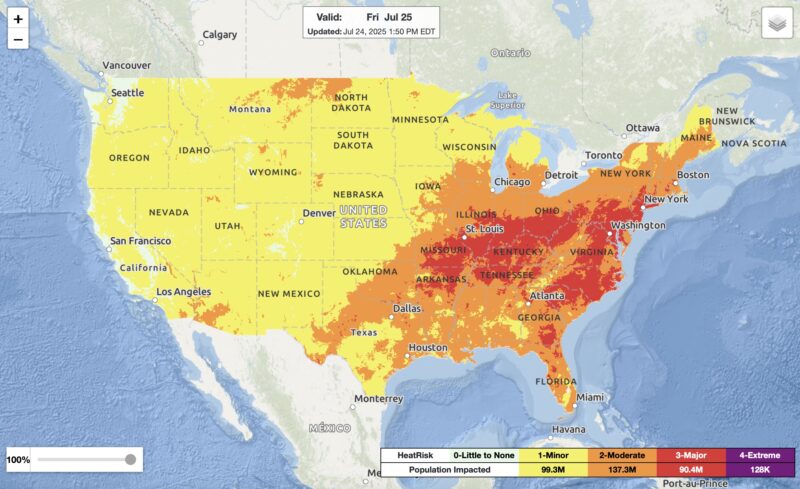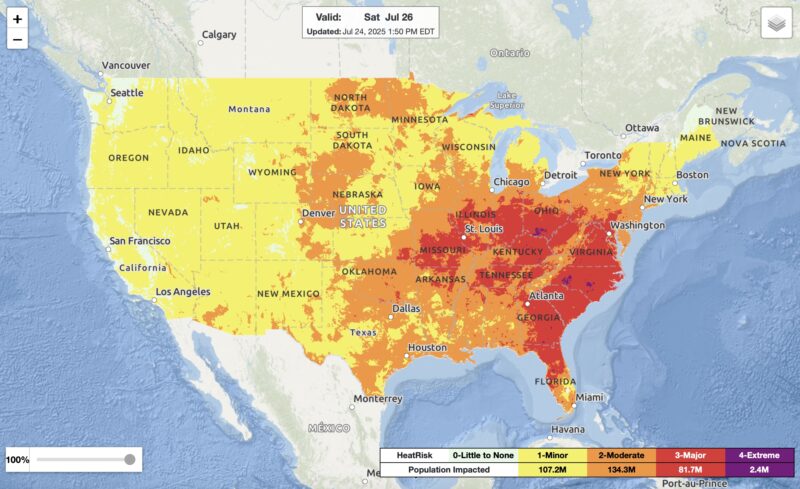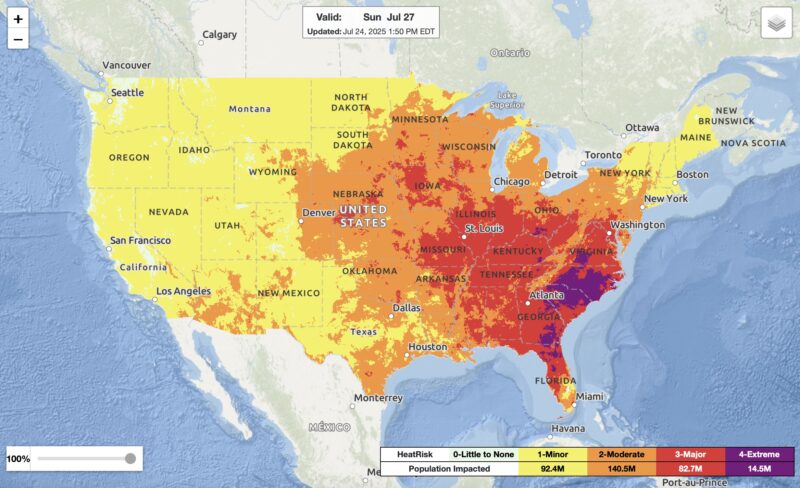
Millions under extreme heat threat across the U.S.
More than 200 million people in the United States will be under the threat of dangerous heat on Friday, through the weekend, and into next week. A large area of high pressure in the middle levels of the atmosphere has settled over the middle and eastern United States. This has created what meteorologists sometimes call a heat dome. This heat dome is creating hot and humid conditions, leading to dangerous and sometimes extreme heat for millions of people.
The National Weather Service is forecasting heat index values (what it feels like when you factor in the humidity) up to 105 degrees Fahrenheit (40 C) for much of the Midwest, Middle Atlantic and Northeast. In some areas, the heat index could reach up to 110 degrees Fahrenheit (43 C).
What is the heat index?
As mentioned before, the heat index is what it feels like with the humidity factored into the air temperature. The higher the humidity, the harder it is for the body to cool down. When you’re hot, your body sweats in an attempt to cool off. That’s because as you sweat, the sweat evaporates in the air. And this evaporation cools your body down to a safe and comfortable level. If the humidity is too high, sweat can’t evaporate as easily. Thus, your body can easily become heat stressed or overheated.
The heat index value directly impacts whether the National Weather Service issues a Heat Advisory or Extreme Heat Watch or Warning. Criteria for these advisories, watches and warnings vary from location to location. But regardless of what the criteria are, if dangerous heat is forecast for your location, take it seriously. It is also important to note that heat index values are calculated in the shade. In direct sunlight, the heat index can be up to 15 degrees Fahrenheit (8.3 C) hotter.
What is the NWS HeatRisk?
The National Weather Service, its parent organization NOAA (National Oceanic and Atmospheric Administration) and the CDC (Center for Disease Control and Prevention) partnered together to create an experimental product that provides a forecast heat risk. NWS HeatRisk highlights that risk using a color and number coding system. The index is from 0 though 4, with 0 (green) representing little to no risk from heat and 4 (magenta) representing extreme heat. In addition to just highlighting the biggest threats from heat, NWS HeatRisk also highlights which people may be most at risk due to heat.
NWS HeatRisk takes into account more than just the heat index. It also how much warmer than normal the temperatures are, the time of year, the duration of the abnormal heat and if temperatures could cause heat-related illness according to CDC data. This makes it a valuable tool for anyone to use to get an idea of how dangerous the heat could be in their location.
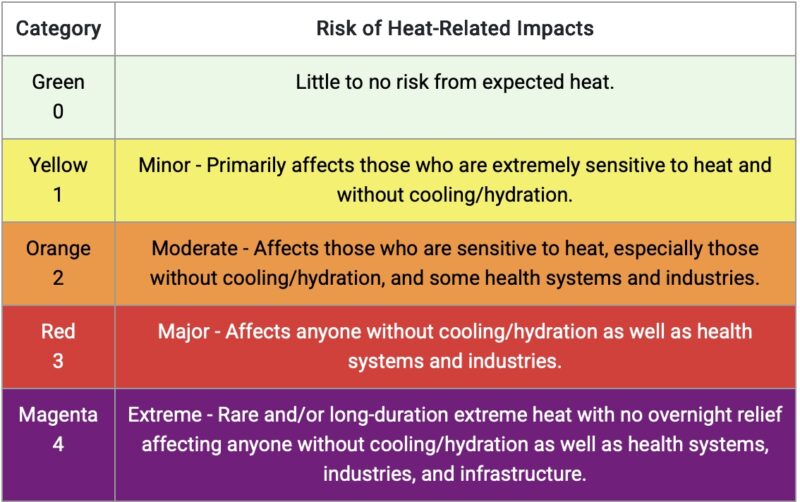
NWS HeatRisk for July 25-27
NWS HeatRisk for Friday, Saturday and Sunday shows more than 200 million people in the United States will be in either Moderate, Major or Extreme risk each day. The Extreme Risk shifts to the southeast and Middle Atlantic Saturday and Sunday.
Staying safe during extreme heat
Heat is the number one weather-related killer in the United States. Hundreds die due to the heat every year. And anyone can feel the impact of heat. However, the very young, elderly, people with chronic medical conditions, pregnant women and people in underserved or impoverished communities are the most vulnerable. This also includes the homeless population and people who can’t afford to run their air conditioning.
During extreme heat, it is important that you avoid spending long periods of time outside. This is especially true during the hottest parts of the day through the early afternoon and early evening. If you cannot avoid being outside, take frequent breaks in air-conditioning, whether that be in a vehicle, a public cooling shelter or your own home. Also take frequent breaks in the shade and drink lots of water. You should wear loose, light clothing in light colors.
You should also never leave a child or pet in a vehicle during the summer heat. Unfortunately, 16 children have already died due to being left in hot cars in 2025. Sadly, the average per year is 37.
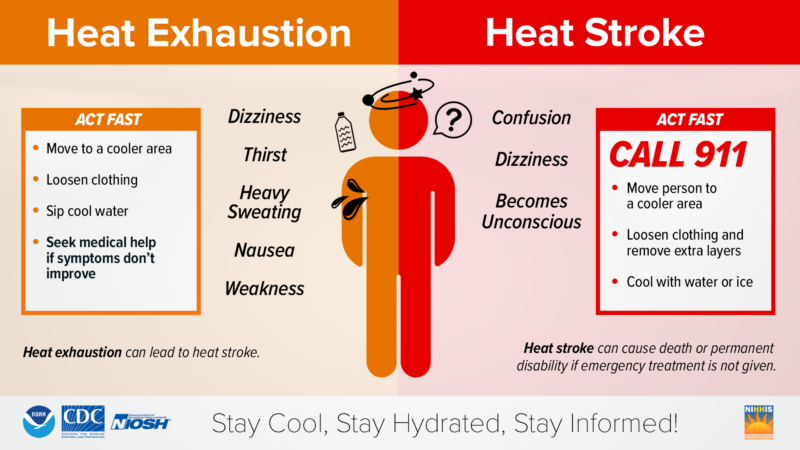
What to do if you begin to feel ill
Here’s what to do if you or someone you’re with becomes dizzy, overly thirsty, is sweating too much or becomes nauseated or weak from the heat. Stop what you’re doing and move to a cool area. Also, loosen clothing and take sips of cool water. This is heat exhaustion, and if not caught early it can lead to heat stroke. Heat stroke is when a person becomes confused, has increased dizziness and eventually passes out. If this happens, immediately call 911. While waiting for medical personnel, get that person to a cooler area, continue to loosen their clothing and try to cool them down with water and ice. Heat stroke can cause permanent damage or death.
Bottom line: Dangerously extreme heat is forecast for the east and middle of the U.S. for the next few days. Here’s how to stay safe.
Read more: What fuels powerful winds? Answers from a weather scientist



